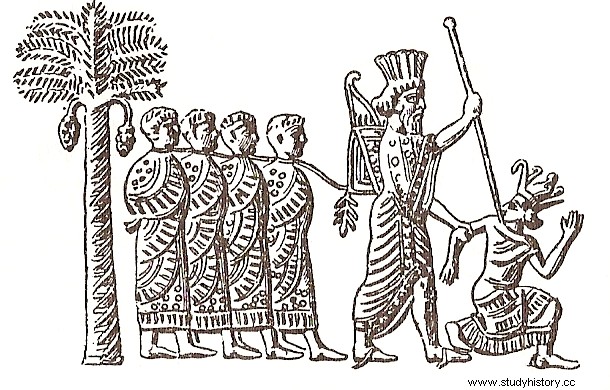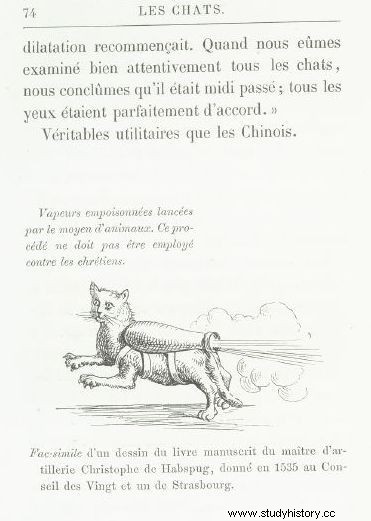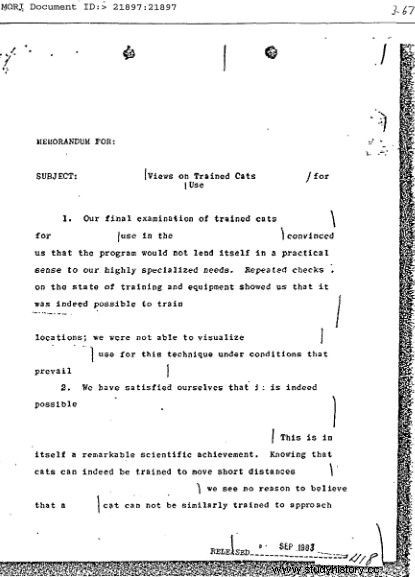Living shields, carriers of chemical weapons, walking wiretaps with an antenna in their tail ... Humanity for at least 2,500 years has been trying to harness cats to work in the armed forces. The effects are, well ... as you'd expect.
1. We can kill people, but not cats!
True military success with the use of cats was achieved only once in history. And it was a truly spectacular success:in 525 BC, furrows brought down the mighty empire of the pharaohs.
The Persian king Cambyses II set out to conquer Egypt and the battle of Pelusium was to decide the fate of the state on the Nile. According to a late message, the Persian king realized how the Egyptians worship cats - they consider them sacred animals and do not allow them to be harmed. The king saw in this an excellent opportunity to confuse the enemy. He had the soldiers scoop up as many cats as possible and place them all in the front line of his army.

Persian seal with the image of Cambyses II taking the pharaoh Psamtik III prisoner. Could it be that the perpetrators of the Egyptians' defeat in the war with Persia were cats, or rather the divine worship they were worshiped on the Nile (source:public domain).
The plan worked flawlessly:Egyptian archers refused to shoot, fearing that by mistake they would hit animals dedicated to the goddess Bastet. - We can shoot Persians, but not cats - they declared. As a result, Cambyses defeated the Egyptian army. The cats survived, but Egypt came under Persian rule.
Unfortunately, it is impossible to confirm whether this story really happened or whether it is just a colorful anecdote. Herodotus, who excels in similar tales, is not mentioned at all about her. However, even if the Battle of Pelusium was completely different, it is difficult to find an account more accurately reflecting the position of cats in Egyptian society. And better showing how other nations approached the deification of the hair ...

One of the pages of Les Chats by Jules Champfleury. It shows a cat used to carry biological weapons (source:public domain).
2. Cats bringing death
In 1869, the French writer Jules Champfleury published a book about cats called simply Cats (fr. Les Chats ). Gathering materials in the library in Strasbourg, he found a 16th-century project to use cats as propagators of biological weapons. The idea was born in the head of a German artillery officer who introduced it to the city authorities in 1535.
The idea was to mount containers with poisonous substances on the cats' backs and let the animals equipped in this way between enemy lines. The German's idea was never realized and his sketches were left untouched for centuries.
3. The Cat Who Knew Too Much
The First World War was accompanied by a true obsession with exposing enemy spies. There was also a feline thread of this paranoia.

During the Great War, the British suspected the Germans of using cats to carry classified information. The illustration shows the Battle of Ypres (source:public domain).
July 1915, Flanders, front line. A dog with two cats regularly crossed the Allied trenches. This did not go unnoticed by the British. They suspected that the Germans were using animals to smuggle messages across the front lines. In one of the reports it was noted that appropriate action had been taken:
Two (2) cats and a dog are under surveillance as they tend to walk through our trenches. Steps were taken to trap them.
The further fate of the animals is unknown.
4. Mobilization of cats
This is not the only feline episode of the great war. William II, Emperor of Germany, threatened that if he ran out of soldiers, he would mobilize all the dogs and cats, but would continue the war.
The German promised, the Turk did. When the Turkish army in southern Palestine prepared to attack Egypt in 1915, it was faced with an incredible plague of rats. Moreover, it affected all of Palestine and even Syria. Food stocks were declining at an alarming rate. The Turkish commander found a way out of the situation:mobilizing the cats.
He had all the furries in the area listed, then announced that the army was requisitioning the animals and, with the help of the animals, proceeded to fight the rats. And maybe it was because of concentration on such activities that the Ottoman Empire collapsed in 1922 ...

CIA document declassified in the 1980s on the use of specially trained (source:public domain).
5. Antenna in the tail
Cats were used not only in the course of traditional armed conflicts, but also during the Cold War. Who watched The Man Staring at Goats knows that the CIA did not hesitate to reach for the most absurd ideas. And so, in the 1960s, it was decided to check whether it was possible for cats to sew a microphone in and use them as listening equipment.
The operation was baptized as "Acoustic Kitty", which can be translated as "Acoustic Kitty". The animal was supposed to be around Soviet diplomats and spies, for example when they were sitting on a park bench. The entire event cost the agency over $ 10 million!
Once the Americans had sewed the cat's microphone in and placed the antenna in its tail, they sent the cat on its first mission. Washington, Wisconsin Avenue, near the Soviet embassy. For a minute or two, everything was going according to plan. The cat was even walking in the right direction. Only that after a while he was run over by a taxi ...

Apparently, the CIA abandoned the project of using cats as agents as early as 1967, but who knows, maybe now squirrels have taken their place? (photo Ray eye; license CC ASA 2.0).
The CIA abandoned the project in 1967. Its authors made a good face for a bad game, saying that the idea wasn't stupid at all, but the number of variables that could make a purring agent's work harder was underestimated.
By the way, in 2007 there was news that Iran suspected of espionage for the USA ... fourteen squirrels, which were to be sewn in with miniature microphones and webcams. So maybe the project was not abandoned at all?
